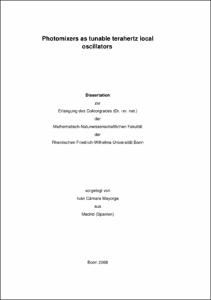Cámara Mayorga, Iván: Photomixers as tunable terahertz local oscillators. - Bonn, 2008. - Dissertation, Rheinische Friedrich-Wilhelms-Universität Bonn.
Online-Ausgabe in bonndoc: https://nbn-resolving.org/urn:nbn:de:hbz:5N-15703
Online-Ausgabe in bonndoc: https://nbn-resolving.org/urn:nbn:de:hbz:5N-15703
@phdthesis{handle:20.500.11811/3695,
urn: https://nbn-resolving.org/urn:nbn:de:hbz:5N-15703,
author = {{Iván Cámara Mayorga}},
title = {Photomixers as tunable terahertz local oscillators},
school = {Rheinische Friedrich-Wilhelms-Universität Bonn},
year = 2008,
note = {This work reports on the development of the photomixing technology and its immediate application to realize a tunable coherent source in the terahertz (THz) frequency range with an unprecedented bandwidth. An extensive experimental study of low-temperature-grown gallium arsenide (LT- GaAs) and ion-implanted GaAs as photomixing materials is performed in order to determine the optimal material parameters and fabrication conditions.
Defect Engineering allows to create photoconducting materials with outstanding properties for THz signal generation. The type and concentration of semiconductor defects has a critical importance in the performance of the material used for photomixing. In LT-GaAs, defects are highly dependent on the arsenic beam equivalent pressure (BEP), growth and anneal temperature. Unfortunately, the growth temperature at which an LT- GaAs sample shows optimal properties lacks very often of fabrication reproducibility. In contrast to LT-GaAs, the defects created in ion-implanted GaAs can be tailored by varying the implantation dose and energy. In order to achieve a given concentration of defects, Monte Carlo simulations were performed to determine optimal implantation conditions. The precise control over implantation dose and energy allows to overcome the reproducibility limitations of LT-GaAs.
Photomixers were fabricated patterning Ti/Au interdigitated electrodes by electron beam lithography on the feed point of different planar antenna designs (resonant dipoles and broadband logarithmic spirals). Electromagnetic simulations of the radiating structures are shown. In addition, semiconductor simulations were performed, revealing the build-up of space charge regions next to the electrodes. The problematic of space charge formation is analyzed and discussed.
Experiments with optimized photomixers demonstrate successfully pumping of astronomical heterodyne receivers at 450 GHz with a superconductor-insulator-superconductor (SIS) mixer and at 750 GHz with a hot-electron-bolometer (HEB) mixer. The double sideband (DSB) noise temperature of the astronomical receiver pumped by a photomixer and by a solid state local oscillator (both measured at an intermediate frequency band of 2 to 4 GHz) were identical (Treceiver = 170 K).
In addition to the photomixing results, the issue of frequency stabilization of free-running lasers is covered. Experiments were performed using an optical comb generator as a relative frequency reference. Under the frequency lock condition, the beat signal fulfilled the linewidth requirements for the photomixing system to be used as a local oscillator for heterodyne receivers in radio astronomy.},
url = {https://hdl.handle.net/20.500.11811/3695}
}
urn: https://nbn-resolving.org/urn:nbn:de:hbz:5N-15703,
author = {{Iván Cámara Mayorga}},
title = {Photomixers as tunable terahertz local oscillators},
school = {Rheinische Friedrich-Wilhelms-Universität Bonn},
year = 2008,
note = {This work reports on the development of the photomixing technology and its immediate application to realize a tunable coherent source in the terahertz (THz) frequency range with an unprecedented bandwidth. An extensive experimental study of low-temperature-grown gallium arsenide (LT- GaAs) and ion-implanted GaAs as photomixing materials is performed in order to determine the optimal material parameters and fabrication conditions.
Defect Engineering allows to create photoconducting materials with outstanding properties for THz signal generation. The type and concentration of semiconductor defects has a critical importance in the performance of the material used for photomixing. In LT-GaAs, defects are highly dependent on the arsenic beam equivalent pressure (BEP), growth and anneal temperature. Unfortunately, the growth temperature at which an LT- GaAs sample shows optimal properties lacks very often of fabrication reproducibility. In contrast to LT-GaAs, the defects created in ion-implanted GaAs can be tailored by varying the implantation dose and energy. In order to achieve a given concentration of defects, Monte Carlo simulations were performed to determine optimal implantation conditions. The precise control over implantation dose and energy allows to overcome the reproducibility limitations of LT-GaAs.
Photomixers were fabricated patterning Ti/Au interdigitated electrodes by electron beam lithography on the feed point of different planar antenna designs (resonant dipoles and broadband logarithmic spirals). Electromagnetic simulations of the radiating structures are shown. In addition, semiconductor simulations were performed, revealing the build-up of space charge regions next to the electrodes. The problematic of space charge formation is analyzed and discussed.
Experiments with optimized photomixers demonstrate successfully pumping of astronomical heterodyne receivers at 450 GHz with a superconductor-insulator-superconductor (SIS) mixer and at 750 GHz with a hot-electron-bolometer (HEB) mixer. The double sideband (DSB) noise temperature of the astronomical receiver pumped by a photomixer and by a solid state local oscillator (both measured at an intermediate frequency band of 2 to 4 GHz) were identical (Treceiver = 170 K).
In addition to the photomixing results, the issue of frequency stabilization of free-running lasers is covered. Experiments were performed using an optical comb generator as a relative frequency reference. Under the frequency lock condition, the beat signal fulfilled the linewidth requirements for the photomixing system to be used as a local oscillator for heterodyne receivers in radio astronomy.},
url = {https://hdl.handle.net/20.500.11811/3695}
}






